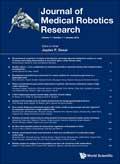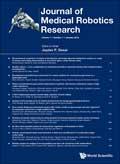
Credit: World Scientific
In a paper to be published in the Journal of Medical Robotics Research, a team of researchers have discovered a way to automate blunt dissection using the da Vinci surgical robot, which is controlled by the Da Vinci Research Kit (DVRK).
Blunt dissection is the surgical separation of tissue layers by means of a blunt instrument. In most surgical procedures, blunt dissection takes up far more time than sharp dissection, which can be described as the practice of cutting through tissues with a sharp instrument. Due to this, any innovation that can make the process of blunt dissection easier, safer or faster could significantly improve the lives of both surgeons and patients alike.
A good way to make blunt dissection easier, safer, and faster is to automate it. Here's a general overview of how the automation of surgical procedures is done. Surgical operations are first described as a series of tasks known as a Surgical Process (SP). An ontology, or a complex data/knowledge representation system based on the accurate description of agents in surgery, is developed to represent the SP in a way that allows it to be analysed in an automated manner. A Surgical Process Model (SPM) is then created to simplify the SP into a pattern that can be performed with support from a workflow management system.
Recently, a team of researchers comprising Dénes Ákos Nagy, Tamás Dániel Nagy, Renáta Elek, Imre J. Rudas and Tamás Haidegger have discovered a way to automate blunt dissection using the da Vinci surgical robot, which is controlled by the Da Vinci Research Kit (DVRK). The team decided to automate blunt dissection as it is performed during Laparoscopic Cholecystectomy (LC), or the procedure by which the gall bladder is removed by keyhole surgery. First, they read the surgical literature on LC and watched videos depicting the procedure. Based on this information, an SPM was created and the portion of the SPM which involved blunt dissection was selected for further study. An algorithm was written to control and monitor the execution of the process. The algorithim requires the surgeon to select a start and an end point for the dissection on an endoscopic image. The 3D field is then reconstructed and the dissection line between the boundary points identified. The computer vision algorithm selects one point on this line with the least depth and the surgical robot executes blunt dissection at this point. When the dissection is complete, the program checks if the target anatomy is exposed. If not, the algorithm reinitiates the dissection line and starts the process again.
To test the performance of this algorithm, the team created an object consisting of two outer layers of hard silicone and an inner layer of soft, foamy, dissectable silicone which could be penetrated with the laparoscopic tool. In all the test cases, the dissection progressed on the intended dissection line. The team also tested the sensitivity of the method to texture and rotation. In addition, they tested the method on more realistic objects such as chicken breast, pork shoulder, and duck liver. It was found that the method is highly sensitive to texture but not significantly sensitive to rotation, and that the performance of the method on realistic objects depended largely on the texture of the objects and the lighting. The method performed far better on feature-rich objects than on feature-poor ones.
While further trials are necessary to confirm the reliability and robustness of this method under surgical conditions, it seems that blunt dissection can be carried out by the surgical robot with only the visual data from the stereo endoscopic camera image feed. This means that additional sensors are not required, and that the method can therefore be easily integrated into the current surgical workflow. In the near future, all blunt dissection could be carried out by surgical robots.
If you would like to know more about the research described here, look out for the paper in question in the next issue of the Journal of Medical Robotics Research.
###
For more insight into the research described, readers are invited to access the paper in the Journal of Medical Robotics Research.
COVER IMAGE
Caption: Cover image
Medical robotics has been progressively revolutionizing treatment for at least the past two decades. The Journal of Medical Robotics Research (JMRR) invites fundamental contributions to all areas of medical robotics including clinical evaluation studies. The journal is primarily aimed towards bringing the scientific and technological developments as well as clinical evaluation studies in the area of medical robotics to a wider robotics and clinical audience.
About World Scientific Publishing Co.
World Scientific Publishing is a leading independent publisher of books and journals for the scholarly, research, professional and educational communities. The company publishes about 600 books annually and about 135 journals in various fields. World Scientific collaborates with prestigious organizations like the Nobel Foundation and US National Academies Press to bring high quality academic and professional content to researchers and academics worldwide. To find out more about World Scientific, please visit http://www.worldscientific.com.
For more information, contact Amanda Yun at [email protected].
Media Contact
Amanda Yun
[email protected]
65-646-65775
@worldscientific
http://www.worldscientific.com
Original Source
http://www.worldscientific.com/page/pressroom/2018-05-04-01 http://dx.doi.org/10.1142/S2424905X18410052





